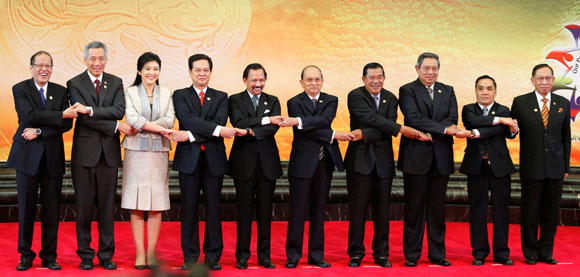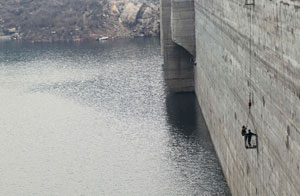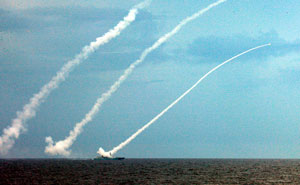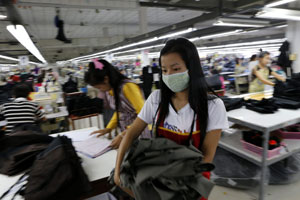Asean member states must quickly evolve their reform agendas and address political challenges if they don’t want to lose out to other emerging regions
By Christian Vits
This year could prove to be a turning point for Asean and its member states. The bloc not only has to pave the way towards the Asean Economic Community (AEC), but also individual countries face the challenge of tackling domestic vulnerabilities.
Economic growth rates will likely remain at levels admired from abroad while they may not reach the highs seen before the financial crisis. At the same time, political conflicts within various countries, and between the bloc members and economic superpowers such as China, will test the region’s ability to stand united and speak with a common voice.

First of all, preparation for the AEC is at the top of the agenda this year, slated to be in place at the end of 2015 – brought forward from an original 2020 launch. While most observers don’t believe the AEC’s ambitious timeframe will be achieved next year, there’s a widespread consensus that it has encouraged Asean member countries to enhance reform efforts. “I think they will get most out of the way, but not 100%,” said Tim Condon, head of research and chief economist for Asia at ING Groep in Singapore. “Asean economic integration is an inexorable trend, as long as there is no backsliding on the market-opening steps that already have taken place.”
The blueprint for the project foresees a reduction or elimination of import tariffs on certain goods and aims to enhance existing trade agreements. Other key points include the lowering of barriers for the free flow of services and capital and the expansion of a regional foreign-exchange pool to tackle financial crises. Last but not least is one of the most politically sensitive issues: the intention to facilitate the migration of skilled labour.
“One should not expect in 2015 to see Asean suddenly transformed, its nature and processes abruptly changed, its members’ interests substantially altered,” wrote Jayant Menon,
a senior economist at the Asian Development Bank (ADB) and Asean’s former secretary general, Rodolfo Severino, in a recent study on the community. It said that 2015 should be viewed as “a work in progress rather than as a hard-target year“. At the same time, “any failure to deliver will likely lead to a loss of credibility, putting member countries in danger of falling further behind the global competition for export markets and foreign direct investment (FDI),” the report warned.
Challenges remain widespread: A joint survey by the ADB and the Institute of Southeast Asian Studies (ISEAS), with a sample size of 381 enterprises in nine Asean countries, revealed that 55% of the respondents were not aware of the 2015 AEC. The report noted that the business community’s interest in AEC 2015 is driven by the actual process of economic integration. “We can infer from this that the lack of awareness of AEC 2015 in the business community can be attributed to the lack of actual economic integration,” the authors said.
A more positive result was yielded by a survey conducted by the Asean Business Advisory Council among 502 firms from all Asean member economies. Almost 60% of the businesses surveyed said Asean economic integration would provide a high or very high opportunity for their organisations. The integration “is seen more as an opportunity than a threat for business”, the council concluded. It also noted that Asean’s attractiveness continued to be rated higher than China’s, both as a market for goods and services and as a production location.

The council “strongly urged to strengthen the process of information dissemination and consultation with businesses on AEC initiatives.” This also shows that Asean’s integration follows more a top-down rather than a bottom-up approach.
A second major topic for Asean this year will be the world’s changing economic environment. Growth in China is losing steam and while Europe slowly recovers, export demand from these and other areas in the world might not fuel Asean economies as much as they did in the past.
The economies pooled in Asean are expected to expand by 5.2% on average this year, compared with 4.8% growth in 2013, according to the ADB. This compares with the world’s projected economic expansion of 3.7%. “It is still a weak and uneven recovery [of the world economy], and downside risks remain,” said Olivier Blanchard, chief economist at the International Monetary Fund (IMF).
The risks entail a slowdown in growth rates in the world’s weak spots and particularly in China, hurting export demand in the Asean region. “The export-led growth model enabled Asean to leverage globalisation into strong domestic growth,” said Condon, who formerly worked at the World Bank. “Slower global growth means slower trade growth, and the economies of Asean will need to rely more on domestic spending.”
While developing Southeast Asian countries such as Malaysia may have the leeway to adjust to changing growth patterns and encourage private consumption and public spending, the less-developed bloc members’ ability will be limited.
Cambodia is a case in point. “I think the economy is not mature enough to push local consumption for economic expansion. Our export-led policy will continue to stay on for the mid to long term,” said Sun Chanthol, the country’s minister of commerce. “Today, our gross domestic product (GDP) per capita has reached $1,000. As soon as this rises, we will start to increase local consumption,” he added.
Apart from that, tightening of monetary policies means that the era of super-cheap and abundant money is nearing an end. That reduces the amount of cash pouring into assets and projects in emerging economies, as investments in developed countries might become more attractive if interest rates there are going to be on the rise again.
“Managing capital flows, both inflows and outflows, which is partly related [to the central bank’s tightening] remains a key issue in the region, in particular in the first half of 2014, […] given the different growth prospect, interest rates, and so on,” said Kensuke Tanaka, head of the Asia desk at the Organisation for Economic Cooperation and Development (OECD) in Paris. “In the near term, capital controls might be useful, but in the long run, the development of bond markets is inevitable.”
Several Asean financial markets were rocked already in May last year, when former US-Fed boss Ben Bernanke announced the central bank’s intention to tighten its ultra-lax monetary policy. As a consequence, many Asean countries faced capital outflows.

“As US monetary policy normalises, [emerging market and developing economies] will face tighter financial conditions,” IMF’s Blanchard said. While fears that Asean could face another financial crisis seem to be exaggerated, reforms are of the essence. “The region is now showing wear. Easy money and an altogether lofty ride reduced the pressure for reforms, productivity growth slowed and credit dependence increased,” HSBC economists Qu Hongbin and Frederic Neumann wrote in a recent research paper. “This year, in short, will be a year for retooling the region’s economies.”
Reduced capital inflows may also turn out to be a dangerous bottleneck for Asean’s growth ambitions, in particular with a view to costly infrastructure projects. Between 2010 and 2020, the region will need to invest $8 trillion, or $730 billion per year, in its infrastructure, according to the ADB. As government investments in infrastructure compete with those in education and healthcare, new solutions have to be explored to attract the necessary funds. To overcome budget constraints, some governments aim to get private investors on board with so-called Public-Private Partnerships (PPP).
Still, the success so far remained limited. The Philippines, for instance, prepared more than 16 PPP projects worth more than $4 billion, but only successfully bid out two of them.
Along with its rapid economic development, Southeast Asia has also developed an insatiable hunger for energy. Energy demand in Asean’s ten member states is projected to jump by more than 80% in the period to 2035, according to the calculations of the International Energy Agency (IEA).
The dependency on oil imports will double by 2035, inflating the region’s oil bill, particularly in Indonesia and Thailand, translating into a higher vulnerability to disruptions and supply shocks. This goes along with massive energy subsidies in many Asean countries. The IEA estimates that fossil-fuel subsidies amounted to $51 billion in 2012, scaring off investors as prices did not reflect real costs.
Increasing income inequalities across the region are another problem, which still needs to be clearly addressed. “The chronic gap between the incomes of the richest and poorest citizens is seen as the risk that is most likely to cause serious damage globally in the next decade,” the World Economic Forum said in its Global Risks Report for 2014 after surveying more than 700 global experts.
“Seven out of every ten people in the world live in countries where inequality has increased since the 1980s and 1% of the world’s families now own 46% [or $110 trillion] of its wealth,” Oxfam International revealed at the end of January.
Other concerns about the region relate to homemade problems in individual countries. Vietnam is still struggling to reform its battered state-owned enterprises and the country’s banking sector. Indonesia has begun to fight its massive current account deficits, and Malaysia needs to tackle huge budget shortfalls.

In addition, political mine fields increase uncertainty about the way forward. “There will be big political changes in the region in 2014 that will potentially affect the growth prospect,” Tanaka said. In July, there’s the presidential election in Indonesia, and the recent turmoil in Thailand has already hampered the country’s economic recovery and cast doubt about the political future of the country.
“If the protests continue, which show the far-reaching political rift in the country, the economic effects of ongoing protests could be devastating,” said Gerhard Will, a Southeast Asia expert at the German Institute for International and Security Affairs in Berlin. “The repercussions would be significant not only for Thailand, but for the whole region, as the country is a key player in Asean’s integration process.”
Moreover, a bigger, more region-wide political escalation is looming over territorial claims in the South China Sea. China, Asean’s biggest trading partner, is at loggerheads with the Philippines, Vietnam, Malaysia and Brunei over the strategically important waters. China claims almost the entirety of the sea.
In December, the superpower flexed its muscles and sent its aircraft carrier Liaoning and four other warships into the disputed area. One of the ships nearly collided with a US warship. Since January, Hainan province has required foreign fishing boats to ask permission to enter waters surrounding the island province, a large area that the provincial government claims to be Chinese.
“The Hainan declaration was a clear escalation,” said Will. “The fact that China insists on resolving tensions over the South China Sea on a bilateral basis is a sign that they intend to break up Asean’s political community. The region’s economic integration is moving forward while political integration remains in its infancy.”
Given all of these political conflicts and economic challenges, the overall impressive economic outlook seems to be somewhat clouded. If the region wants to restore growth to its past vibrancy, governments have to focus on one area: vigorous structural reforms and cooperation.
